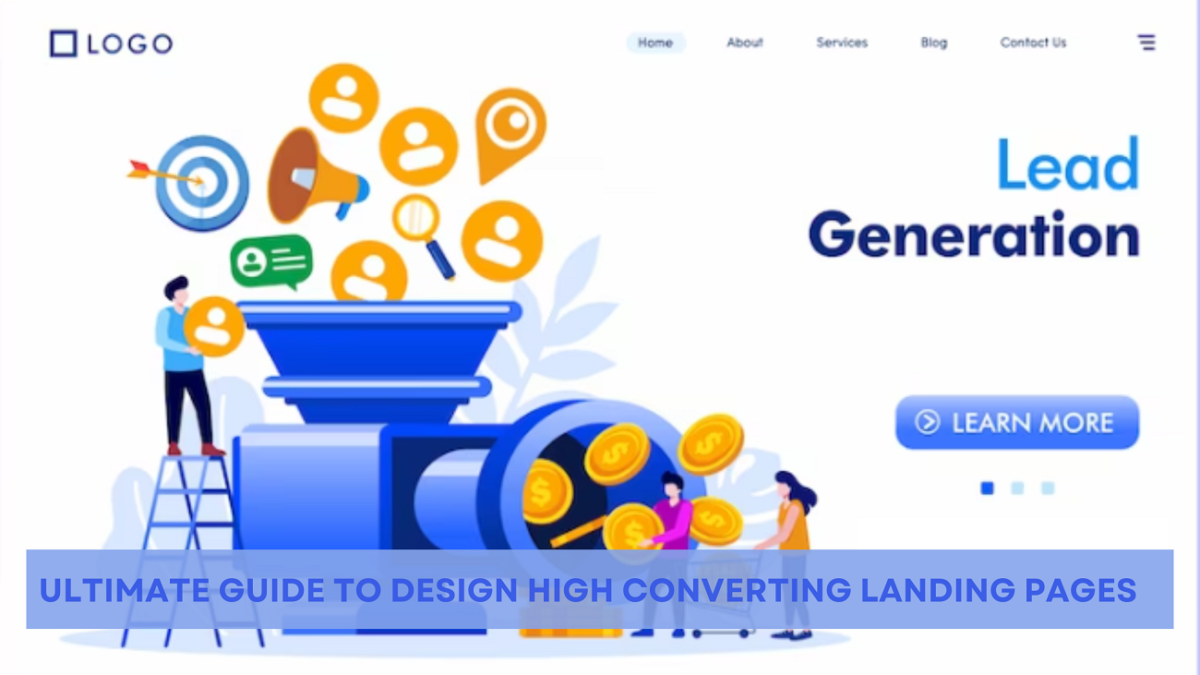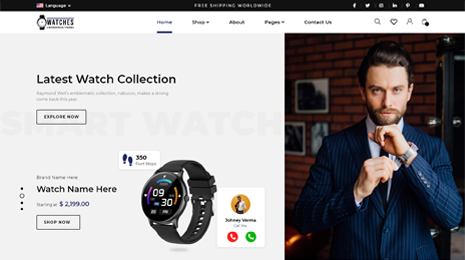A landing page is a web page designed specifically for the conversion of page visitors into leads. It provides relevant and valuable information about a products, services or offers.
A landing page is usually a standalone page without a navigational menu or links to other pages. It is optimized to capture the visitor’s attention. Landing page should encourage them to take a specific call to actions, such as filling out a form, making a purchase, or subscribing to a newsletter.
Landing pages can be used in various online marketing campaigns, including pay-per-click advertising, email marketing, social media advertising, and affiliate marketing. They are an essential component of any successful digital marketing strategy and can impact the effectiveness of your online campaigns.
Difference Between Landing Page and Website Page
A landing page and a website page are both web pages, but they serve different purposes and have different characteristics. Here’s a breakdown of the differences:
Purpose:
A landing page is a standalone web page designed to achieve a specific marketing or advertising goal, such as promoting a product or service or collecting user information. Its purpose is to encourage visitors to take a specific action, such as filling out a form or making a purchase.
A website page, on the other hand, can have a variety of purposes, such as providing information about a company or its products, showcasing a portfolio, or offering educational resources.
Design:
A landing page typically has a simple and focused design, with minimal distractions and a clear call-to-action (CTA) button. The content is optimized to persuade the visitor’s mind to take the desired action.
On the other hand a website page may have a more complex design and structure to improve engagement of the visitors along the webpage. To make it more interactive, it may contain multiple sections, menus, and links.
Navigation:
A landing page typically has limited navigation options that might distract visitors from the main CTA. On the other hand, a website may have a variety of navigational menus and links to different sections and pages of your website. These links will help your website visitors to remain engaged and explore the website to get purposeful information.
Traffic source:
Landing pages are often designed to be accessed from specific traffic sources, such as a targeted advertising campaign from Google Ads, Facebook, LinkedIn, Twitter, Pinterest. You can also opt to drive your visitors from an email marketing campaign.
A website page, on the other hand, can be accessed from a variety of sources, such as search engines, social media, reference links, or direct traffic.
Analytics:
Because landing pages are designed with a specific call to action goal, they can be optimized and tracked more easily than website pages. Marketers can use tools such as A/B testing and analytics to measure the performance of different landing pages and reoptimize them for better results.
Website pages, on the other hand, may have unspecified and multiple goals that make them to be more difficult to optimize and track.
Types of Landing Pages
There are several types of landing pages, each designed for a specific purpose. Some common types of landing pages include:
Click-Through Landing Pages
These types of landing pages leads visitors to click on the desired button or link. It can make visitors go to the next page, such as a product page or a registration page.
Lead Generation Landing Pages
Development of these kinds of landing pages capture a visitor’s contact information, such as their name and email address. You can acquire valuable information of prospects in exchange for something of value, such as a free eBook or a newsletter subscription.
Sales Landing Pages
Designing of these types of landing pages persuade visitors to make a purchase, typically by highlighting the benefits and features of a product or service.
Event Landing Pages
Event landing pages promote and provide information about an upcoming event, such as a webinar, conference, or workshop.
Product Landing Pages
Product landing pages helps to showcase a single product or service, typically with a focus on its features, benefits, and pricing.
Squeeze Landing Pages
The main motive behind designing squeeze landing pages is to collect a visitor’s email address, typically with the promise of providing valuable content or offers in return.
Viral Landing Pages
Viral landing page type encourages visitors to share the page with their social networks, typically by offering incentives or rewards for doing so.
Landing Page Design Tips
As we have discussed, landing pages are built with the motive to make visitors perform certain call to actions, it must need to have good experience elements. activities.
If you want best performing landing pages, it should have a clear and concise headline, a relevant and compelling offer, a strong call-to-action, social proof, and a visually appealing design.
A successful landing page should have the following key elements:
Clear and Compelling Headline
The headline should grab the visitor’s attention and clearly convey the value proposition of your offer. It should be brief, specific, and benefit-driven.
Strong Call-to-Action (CTA)
The CTA should be prominent and visually appealing, making it easy for visitors to take purposeful actions. It should also be aligned with the headline and the offer.
Relevant and Engaging Visuals
The visuals on the landing page should be relevant to the offered services and products . Appealing media files enhance the message of the page and make it more engaging.
Brief and Focused Copy
The copy on the landing page should be brief and focused on the benefits of the offer. It should be easy to read and use persuasive language to encourage visitors to take purposive actions.
Social Proof
Social proof is a powerful tool that can help build trust and credibility with visitors. It can include customer testimonials, reviews, awards, or endorsements from credible sources.
Mobile-Optimized Design
With the increasing number of mobile users, it’s crucial that your landing page is optimized for mobile devices. The page should be easy to navigate, load quickly, and have a responsive design.
Clear and Simple Navigation
The navigation on the landing page should be simple and easy to understand. It should guide visitors towards the CTA and other relevant information without distracting them from the main goal of the page.
By incorporating these key elements, you can create a page that is both visually appealing and powerful at converting visitors into customers or leads. If you are not tech savvy, you can purchase a landing page WordPress theme and can make necessary changes and good to go.
What is A/B Testing and Why is it Important for Landing Pages
A/B testing is a method of comparing two versions of a landing page to determine which one is more effective in achieving the purposive goals.
A/B testing allows you to test different variations of the landing page to see which one performs best. This can help you optimize the page and improve conversion rates over time.
Common Mistakes to Avoid While Designing a Landing Page?
Landing pages help to acquire leads and it can have a significant impact on the success of a marketing campaign. Irrelevant and uncompelling landing pages can discourage them to take the desired actions, such as filling out a form, making a purchase, or subscribing to a service.
Following are some of the common mistakes that you should avoid while designing persuasive landing pages. Common mistakes to avoid when designing a landing page include cluttered design, unclear messaging, poor call-to-action placement, and lack of social proof.
Lack of Clarity:
Landing page should be clear with the goal and to the point. Visitors should immediately understand what the page is about, what they can expect to find on it, and what action they can take.
Poor Navigation
Use simple and minimal navigation options as overwhelming visitors with too many options or links could distract them from the main desired call-to-action.
Slow Load Times
Slow load times can be a major turnoff for your prospects. Make sure your landing page loads fast, which can help reduce bounce rates and improve conversions.
Confusing Call-to-Action
Concise landing page with clear and prominent call-to-action. This makes it easy for visitors to take the desired action, whether your goal is to sign them up for a newsletter or want them to make a purchase.
Lack of Visual Appeal
Your landing page should be visually appealing and engaging. Use high-quality images and graphics to make landing pages visually appealing and engaging. Eye catching pages are subject to grab visitors attention and keep them on the page.
Inconsistent Branding
Your landing page should be consistent with your brand identity like logo, brand name and messaging. Make sure the colors, fonts, and overall design align with your brand.
Too Much Text
Avoid too much texting on a landing page as it can be overwhelming for visitors. Focus on concise messages and visuals to break up large blocks of text.
Not Mobile-Friendly
Mobile friendly landing pages are the need of the smartphone era, where more people access web on mobile devices. Optimize landing pages for smaller screens and easy to navigate with touch controls.
By avoiding these common errors, you can design a landing page that effectively communicates your messages to visitors. It engages visitors, and drive them to take desired actions.













